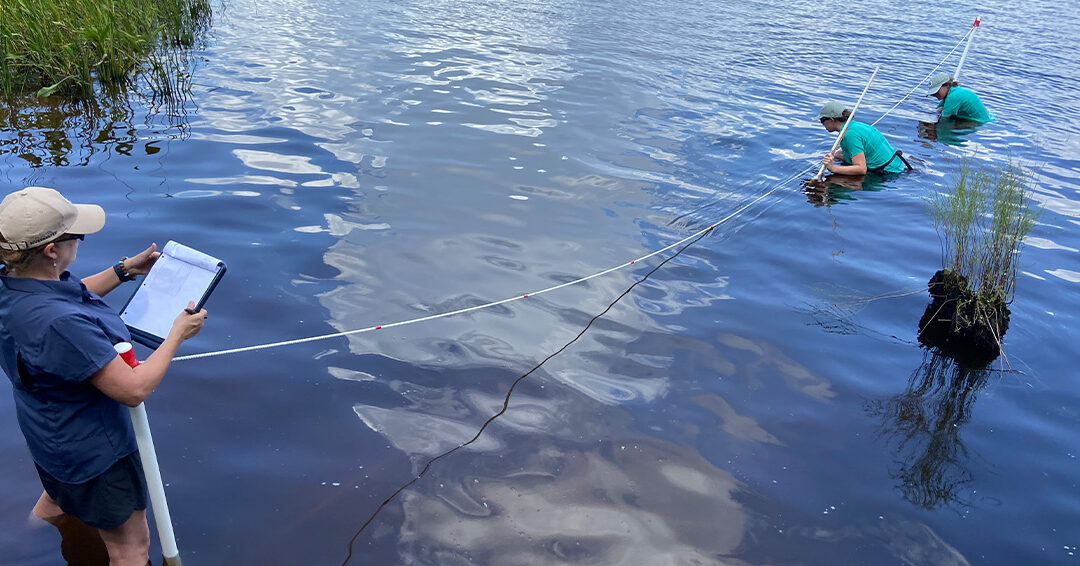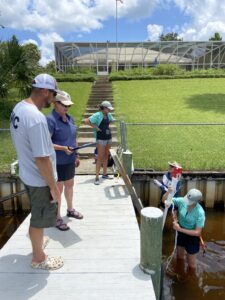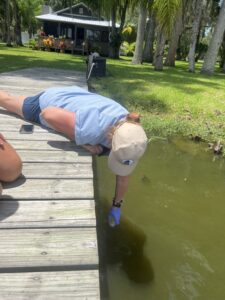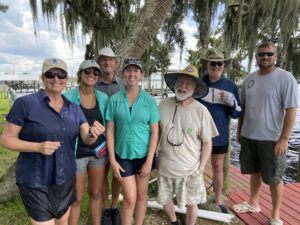St. Johns Riverkeeper’s (SJRK) SAV Team wrapped up the August 2023 SAVe our River’s Grasses Expedition a day early due to persistent streaks of cyanobacteria on the surface water at each monitoring site south of Dunn’s Creek.
The August 2023 Expedition results were mixed with both encouraging and discouraging findings.
 First, the good news:
First, the good news:
SJRK’s SAV Team found fledgling grasses at the Doctors Lake site where none existed during the May 2023 Expedition. It was an excellent kickoff that we celebrated with area residents who joined us to observe our early morning monitoring.
SAV was also found at the Fruit Cove site. The river’s grasses were widespread at this location but cropped short by hungry grazers, most likely turtles and/or manatees.
One of the most exciting highlights was the presence of long, healthy grasses within a large-scale enclosure at Dancy Point and a smaller enclosure at San Mateo. The Dancy Point enclosure is part of a Florida Fish & Wildlife Conservation Commission (FWC) pilot project. FWC installs fencing to protect grasses from grazers, which gives our river’s SAV a fighting chance.
 Now, the bad news:
Now, the bad news:
Outside the Dancy Point enclosure, SAV was cropped short like all the other unprotected areas demonstrating the significant grazing pressure due to limited food sources and SAV throughout the Lower St. Johns.
Seven of the thirteen sites had evidence of cyanobacteria on the surface, within the water column or in the river sediments. Cyanobacteria, also known as harmful algal blooms, can be highly toxic and dangerous to our health. Algae presence also blocks out sunlight that SAVs need to grow. Toxin analysis is pending.
Out of an abundance of caution, the SJRK SAV Team only took water quality samples, algae samples, and shoreline observations of the SAV at these sites. Chara, an SAV that is a type of macro algae, was observed at the Welaka, Beecher Point, and Drayton Island sites. The Chara was much thicker and longer than documented in the May 2023 Expedition. St. Johns River Water Management District scientists consider Chara as a precursor species to eelgrass, so the SJRK SAV Team and area residents hope to see eelgrass presence soon (see page 9 of the May 2023 Expedition Overview).
 Connecting for Our River
Connecting for Our River
Once again, the SJRK SAV Team was thrilled to meet with residents, concerned citizens, scientists, fishermen and river enthusiasts throughout this 80-mile stretch of the St. Johns River. Shared passion, concern and dedication instills a bond and a foundation for our work together to #SAVeTheStJohns.
Thanks to all who joined us on the river during the August 2023 SAVe our River’s Grasses Expedition.
Next Steps
A more detailed account of our data, conversations and experience will be released later this month.
We will return to this 80-mile stretch of the river’s most threatened habitat in mid-October 2023.
Help us Make a Difference
Each SAVe our River’s Grasses Expedition that St. Johns RIVERKEEPER conducts costs approximately $5,000. If staff finds it necessary to collect samples for testing, these costs can go up tremendously.
Please consider a gift to help support St. Johns RIVERKEEPER’s SAVe our River’s Grasses Expeditions and SAV research so that we can continue this vital work in some of the most threatened habitat of our watershed. Choose the “Program – SAV Research” cause on our giving form if you’d like to specifically support this endeavor.

 First, the good news:
First, the good news: Now, the bad news:
Now, the bad news: Connecting for Our River
Connecting for Our River